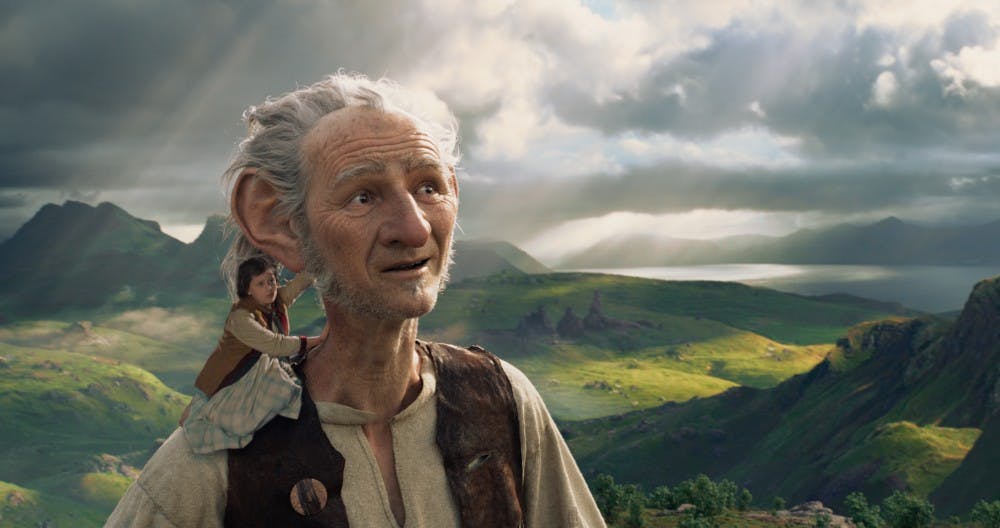Grade: B-
Steven Spielberg’s movie adaptation of “The BFG” is lovely to watch, but fails to leave much of an impression.
The film struggles with pacing and tone — Spielberg doesn’t seem to know whether he wants to market the movie to nostalgic older book readers or the children who are being introduced to the movie now.
Therefore, much of “The BFG’s” success is rooted in style over substance — it’s a beautiful movie, but in between the twinkling lights and CGI’d gastronomical effects, very little actually happens.
Based on the 1982 classic children’s book by Roald Dahl, “The BFG” follows Sophie, a bright, precocious orphan in London, whose late-night excursions result in an accidental giant-spotting and subsequent kidsnatching.
Fortunately, the giant Sophie encounters is the BFG, or Big Friendly Giant, the resident of Giant Country who collects and shares dreams with humans as they sleep and eats vegetables called “snozzcumbers” instead of humans.
Comparatively small and far less menacing, the BFG struggles to reconcile his belief the giants should stop eating people with his feelings of powerlessness.
When the giants’ eating habits endanger Sophie, the two devise a plan to rid England of their bloodthirsty ways forever.
Relative new kid Ruby Barnhill steals the movie as Sophie.
She is reminiscent of Georgie Henley in “The Chronicles of Narnia” as she navigates the cinematic giant land and scaled-down, human settings with equal ease.
Barnhill’s fellow actors were heavily CGI’d in almost every scene, but her acting chops hold the movie together and manage to ground even the flightiest moments.
The CGI is incredible to look at.
Scenes involving the BFG’s dream catching and mixing are almost worth the price of admission alone, and the visual gags involving “whizpoppers” (you’ll know them when you see them) are amusing.
Rylance’s motion-captured face is wonderfully expressive, but he delivers his lines like he has a mouthful of snozzcumbers.
The other giants are virtually indistinguishable in their motion-captured loutishness (keep an eye out for Bill Hader). As a pack, though, they are appropriately menacing for a children’s movie.
Spielberg misses the mark, though, when he tries to sanitize some of the book’s darker themes.
Much of the book’s enduring appeal is rooted in the BFG’s outsider look at humanity and giant-kind.
Take this quote: “‘I is not understanding human beans at all,’ the BFG said. ‘You is a human bean and you is saying it is grizzling and horrigust for giants to be eating human beans. Right or left?’
‘Right,’ Sophie said.
‘But human beans is squishing each other all the time,’ the BFG said. ‘They is shootling guns and going up in aerioplanes to drop their bombs on each other’s heads every week. Human beans is always killing other human beans.’”
One could argue an ethical debate on human’s meat-consuming habits versus those of giants is too heavy for a children’s movie.
One could also argue Dahl’s success stemmed from his refusal to talk down to the children he wrote for, or shield them from the odd touch of gruesomeness or gore.
He dropped “adult” ideas into every poem and novel, wrapped up with enough magic and mayhem that it was palatable to young, impressionable minds.
Spielberg doesn’t seem to share that vision.
In his movie, the lesson seems to be something about growing up, or possibly keeping one’s inner child alive, or maybe just the importance of eating a wide variety of vegetables.
Spielberg doesn’t seem to know, which means the audience doesn’t either.
You’ll walk out of “The BFG” feeling dazzled, and a little impressed, but the movie ultimately plays it safe, and a little boring.
Spielberg captures the visual appeal and oddities of Dahl’s book, but he misses the heart.
ahalliwe@indiana.edu | @Anne_Halliwell




